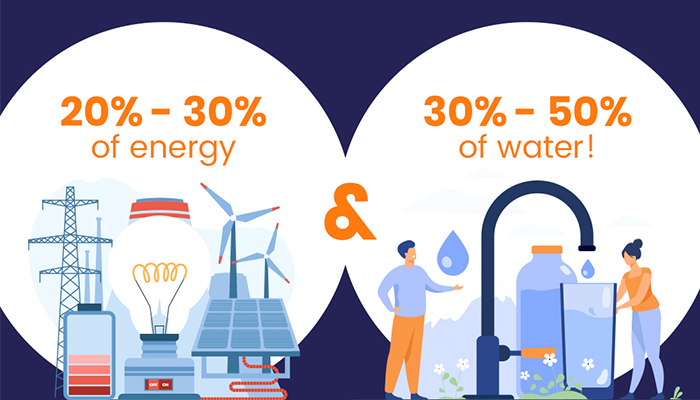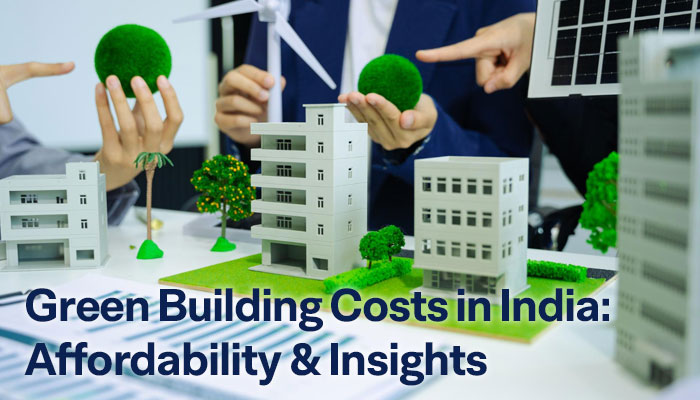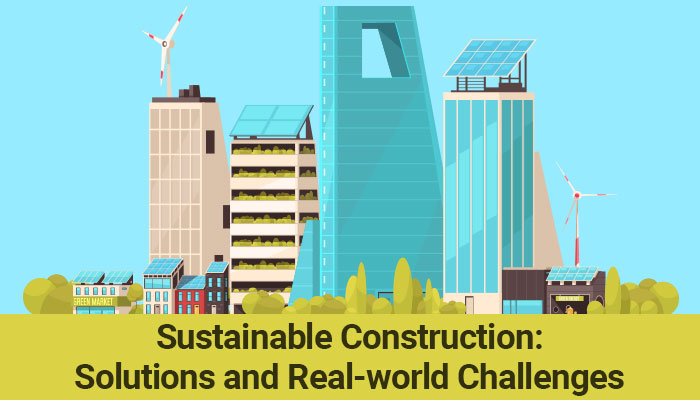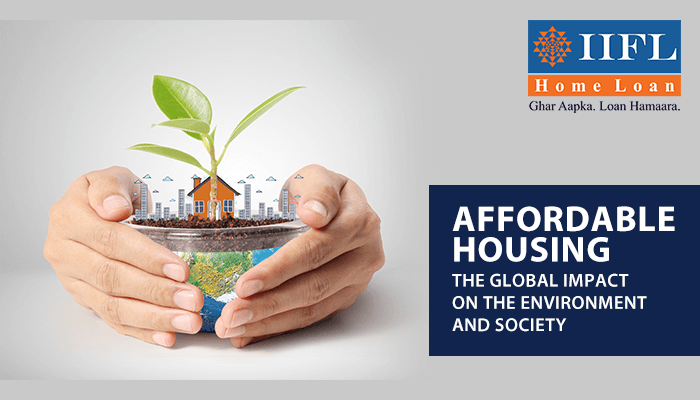Innovation in Sustainability is Bringing Green Building Trends in The Construction Industry

In India, the construction industry employs over 30 million people and creates assets worth more than $200 billion.1 It accounts for more than 5% of the national GDP and 78% of gross capital formation1. Due to tremendous population growth and the incorporation of modern technologies, the Engineering and Construction (E&C) industry has survived the last two years1 despite being one of the world's largest businesses.
The construction industry is seen as a top priority for attaining global sustainability. The sector has the highest material intensity of any industry, consuming 40% to 75% of total material value and contributing to up to 15% of GDP2(OECD, 2018). The amount of waste generated is proportional to the total value of materials used in the supply chain. Buildings are responsible for around almost a quarter of total CO2 gas emissions. The construction sector contributes to GDP, and green building offers the opportunity to increase productivity while minimising environmental effects. Global construction output is predicted to rise significantly in the next few decades, as markets strive for improved resource efficiency.
Sustainability goals and transparency in Environmental, Social, and Governance (ESG) policies are already well established among property enterprises and funds, with some fortune 500 corporations incorporating sustainability into their corporate objectives. The real estate business is increasingly considering the effects of climate change, with large firms notably having policies in place to deal with climate hazards.
Green buildings can reduce their negative environmental impact while preserving resources and improving people's quality of life through their design, construction, or operation. To combat the drain on our resources during construction and operation, buildings are being built to be more sustainable, eco-friendly, and intelligent. These ‘green buildings’ meet stringent resource-efficiency construction criteria and include aspects such as sustainable materials, renewable resources, green roof systems, improved acoustics, clean interior quality, and biophilic habitats. The environmental and economic benefits are substantial, with around 25% less energy used and a 20% decrease in the maintenance costs (Council, n.d.). Climate, cultures, customs, and other economic and environmental factors influence green building design and construction. The process of developing innovation is still in its early stages, but progress is already visible. Building components will get additional functionality as a result of the more dramatic advancements in both the material used as well as process of construction that feature new innovations. Newly constructed green buildings can offer a variety of practical and intangible benefits. The most visible benefits to the end users are the savings in water and energy usage, which begins on the first day of tenancy. Energy savings may range from 20% to 30%, while water savings may range from 30 to 50%3 as a result of using efficient fixtures and sensor-based triggers/switches. Intangible advantages of green new buildings include enhanced air quality, better day lighting, tenant health and well-being, increased safety, and the preservation of unique national treasures.
More companies are anticipated to make the effort as the links between sustainability and financial performance become clearer. According to a 2015 Smart Market World survey, green building accounts for almost one-quarter (24%) of overall construction activity among study participants. India is one of the countries with green building activity that surpasses the market average of 24%.
To address urban challenges, certain legislative and regulatory procedures have been devised and are being implemented through national plans and programmes. The Centre's Ministries and Agencies have created frameworks such as the Environmental Clearance to ensure resource efficiency in large projects (i.e. more than 20,000 sq m built up area). The Energy Conservation Building Code (ECBC) is applicable to air-conditioned commercial buildings with connected loads greater than 100 kW, while the Solar Buildings Programme for Energy Efficient Buildings are to be implemented by designated State agencies and municipal bodies.
The advantages of green grading systems include:
Some of the benefits of green construction are as follows:
-
1. Reduced energy consumption while maintaining comfort levels
-
2. Reduced damage of natural areas, ecosystems, and biodiversity, as well as reduced soil loss due to erosion, among other things
-
3. Pollution in the air and water has been reduced (with direct health benefits)
-
4. Water use has been reduced
-
5. Reduced waste output as a result of recycling and reuse
-
6. Reduced pollution loads
-
7. Enhanced user productivity
-
8. Image and marketability enhancements as certified buildings hold prestige
-
9. Incentives like enhanced FAR offered for different rating systems
Rating Systems are a big boost to promote various eco-friendly technologies in various projects by providing incentives. These systems mainly focus on implementation of passive cooling techniques, efficient resource management during construction and energy efficient fixtures during the lifecycle of the building. Installation of PV Cells, Rooftop Rainwater Harvesting Systems, Soft Scaping, Landscaping, etc. are some of the techniques that are currently being used in both large scale and medium scale buildings to promote green construction. On a broader scale, these systems, as well as the acts and processes that lead up to them, benefit the community as a whole by reducing GHG (Green House Gas) emissions, energy consumption, and the pressure on natural resources.
Apart from rating systems, a few modern age technologies have taken green construction to another level. While most of these technologies are being moulded for everyday usage, they remain potential powerhouses that may be extremely necessary to produce green buildings one day. They are aided by the digitisation of modern age, introduction of IoT, Smart Infrastructure as well as adoption by commercial companies which provide consultation for such services, while utilising it. BIM remains the most widely used simulation tool to produce energy efficient green buildings. Many construction powerhouses throughout the world have been utilising this technology since the last decade to produce better and more efficient structures. Some more are mentioned below:
Building Information Modelling (BIM) is a simulation software used to study effects of different aspects on a building including sun path, wind flow, energy loads, etc. Hence, it will help reduce energy loads, consumption and the environmental impact of a building. BIM offers specific workflows and modelling tips that can help a building become a 'Green Building’.
Augmented Reality (AR) is a digital information layer that augments a view of the real world. Construction professionals can look at a job site with additional information laid directly on top of the picture by using a mobile device with AR capabilities. Augmented reality devices can display real-time safety information to workers by detecting hazards in the environment. They can also aid the implementation of green technologies on site.
Artificial Intelligence (AI) is the ability of technology to act independently without human intervention, whereas machine learning is the ability of technology to learn from past experiences and big data analysis. Both technologies have enormous implications for the construction industry, where efficient and intelligent decision-making has a significant impact on productivity and safety. AI can be used extensively with BIM to create a modular framework for any relative buildings in a microclimate with pre-sets defined as per the client to reduce expected energy loads.
3-D Printing includes layer-by-layer creation by machine. Material is poured slowly forming layers and hence a superstructure. This technique is still in nascent stage and is comparatively on the pricier end. Its advantages are:
-
1. Efficient use of resources/material
-
2. Faster construction
-
3. Efficient and error free construction
Modular Construction is a specialised construction in which structures are built off-site, brought in parts, and then erected by cranes. Because of the regulated environment, modular construction lowers waste. The approach also produces buildings that are efficient, adaptable, and high-performing, and may be reused several times. These buildings are also lighter on the pocket as similar modules are produced in off-site units, which are often mass produced with slight personalisation options. These modules are sometimes specifically ‘Green’ and have a lower impact on the environment. Other green advantages of modular construction include raw material saving, decreased site interruption and waste contamination, and less pollution from cars and heavy equipment.
LiDAR (Light Detection And Ranging) can be used for various purposes, like estimating solar radiation for PV cell calculations (Robinson and Stone, 2004, Lukac et al., 2013), estimating heating energy demand (Tooke et al., 2014), identifying building types and classifying them for respective rating systems. Potential applications for this technology are in ways that overcome the limitations of statistical information to meet the growing demand for accurate and updated energy data for residential planning and urban planning.
The industry's challenge today is ensuring that these innovations are deployed and accepted at scale and in a timely manner across the entire value chain.
Construction companies must keep current on material breakthroughs in order to maintain a competitive advantage. Buildings built using cutting-edge materials will be better able to handle current concerns, reduce their carbon footprint, and have an impact on the industry.
If you have any other way to reduce the CO2 emission through the construction industry, write to us in the comments section.
Sources:
1. Construction Industry of India 2022, https://en.wikipedia.org/wiki/Construction_industry_of_India#:~:text=India%20Construction%20has%20accounted%20for,worth%20over%20%E2%82%B9%20200%20billion.
2. Global investments on the construction and maintenance of infrastructure as share of GDP, https://www.statista.com/statistics/566787/average-yearly-expenditure-on-economic-infrastructure-as-percent-of-gdp-worldwide-by-country/
3. Green jobs handbook, https://sscgj.in/wp-content/uploads/2022/06/Green-Jobs-Hand-Book-PDF.pdf
https://www.grihaindia.org/about-griha
https://sscgj.in/green-construction/
https://www.constructionbusinessowner.com/green/18-green-building-innovations-consider-your-jobsite
https://www.archdaily.com/983893/innovation-in-sustainability-is-driving-green-building-trends-in-the-construction-industry
https://en.wikipedia.org/wiki/LEED
https://www.usgbc.org/leed
https://www.bigrentz.com/blog/construction-technology
Tags
Disclaimer: The information contained in this post is for general information purposes only. IIFL Home Finance Limited (including its associates and affiliates) ("the Company") assumes no liability or responsibility for any errors or omissions in the contents of this post and under no circumstances shall the Company be liable for any damage, loss, injury or disappointment, etc. suffered by any reader. All information in this post is provided "as is", with no guarantee of completeness, accuracy, timeliness, or of the results, etc. obtained from the use of this information, and without warranty of any kind, express or implied, including, but not limited to warranties of performance, merchantability, and fitness for a particular purpose. Given the changing nature of laws, rules, and regulations, there may be delays, omissions, or inaccuracies in the information contained in this post. The information on this post is provided with the understanding that the Company is not herein engaged in rendering legal, accounting, tax, or other professional advice and services. As such, it should not be used as a substitute for consultation with professional accounting, tax, legal or other competent advisers. This post may contain views and opinions which are those of the authors and do not necessarily reflect the official policy or position of any other agency or organization. This post may also contain links to external websites that are not provided or maintained by or in any way affiliated with the Company and the Company does not guarantee the accuracy, relevance, timeliness, or completeness of any information on these external websites. Any/ all (Home/ Loan Against Property/ Secured Business Loan/ Balance Transfer/ Home Improvement Loan/ NRI Home Loan/ Home Loan for Uniformed Services) loan product specifications and information that may be stated in this post are subject to change from time to time, readers are advised to reach out to the Company for current specifications of the said (Home/ Loan Against Property/ Secured Business Loan/ Balance Transfer/ Home Improvement Loan/ NRI Home Loan/ Home Loan for Uniformed Services) loan.
 Login
Login






















